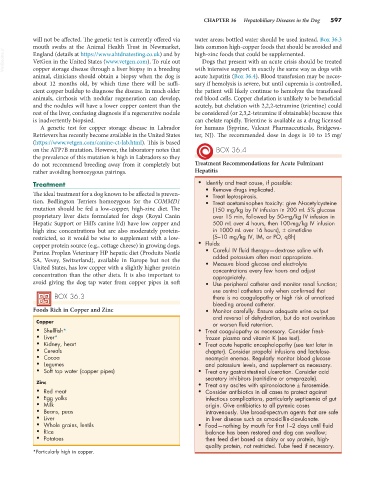Page 625 - Small Animal Internal Medicine, 6th Edition
P. 625
CHAPTER 36 Hepatobiliary Diseases in the Dog 597
will not be affected. The genetic test is currently offered via water areas; bottled water should be used instead. Box 36.3
mouth swabs at the Animal Health Trust in Newmarket, lists common high-copper foods that should be avoided and
VetBooks.ir England (details at https://www.ahtdnatesting.co.uk) and by high-zinc foods that could be supplemented.
Dogs that present with an acute crisis should be treated
VetGen in the United States (www.vetgen.com). To rule out
copper storage disease through a liver biopsy in a breeding
acute hepatitis (Box 36.4). Blood transfusion may be neces-
animal, clinicians should obtain a biopsy when the dog is with intensive support in exactly the same way as dogs with
about 12 months old, by which time there will be suffi- sary if hemolysis is severe, but until cupremia is controlled,
cient copper buildup to diagnose the disease. In much older the patient will likely continue to hemolyze the transfused
animals, cirrhosis with nodular regeneration can develop, red blood cells. Copper chelation is unlikely to be beneficial
and the nodules will have a lower copper content than the acutely, but chelation with 2,2,2-tetramine (trientine) could
rest of the liver, confusing diagnosis if a regenerative nodule be considered (or 2,3,2-tetramine if obtainable) because this
is inadvertently biopsied. can chelate rapidly. Trientine is available as a drug licensed
A genetic test for copper storage disease in Labrador for humans (Syprine, Valeant Pharmaceuticals, Bridgewa-
Retrievers has recently become available in the United States ter, NJ). The recommended dose in dogs is 10 to 15 mg/
(https://www.vetgen.com/canine-ct-lab.html). This is based
on the ATP7B mutation. However, the laboratory notes that BOX 36.4
the prevalence of this mutation is high in Labradors so they
do not recommend breeding away from it completely but Treatment Recommendations for Acute Fulminant
rather avoiding homozygous pairings. Hepatitis
Treatment • Identify and treat cause, if possible:
• Remove drugs implicated.
The ideal treatment for a dog known to be affected is preven- • Treat leptospirosis.
tion. Bedlington Terriers homozygous for the COMMD1 • Treat acetaminophen toxicity: give N-acetylcysteine
mutation should be fed a low-copper, high-zinc diet. The (150 mg/kg by IV infusion in 200 mL 5% glucose
proprietary liver diets formulated for dogs (Royal Canin over 15 min, followed by 50-mg/kg IV infusion in
Hepatic Support or Hill’s canine l/d) have low copper and 500 mL over 4 hours, then 100-mg/kg IV infusion
high zinc concentrations but are also moderately protein- in 1000 mL over 16 hours), ± cimetidine
restricted, so it would be wise to supplement with a low- (5–10 mg/kg IV, IM, or PO, q8h)
copper protein source (e.g., cottage cheese) in growing dogs. • Fluids:
Purina Proplan Veterinary HP hepatic diet (Produits Nestlé • Careful IV fluid therapy—dextrose saline with
added potassium often most appropriate.
SA, Vevey, Switzerland), available in Europe but not the • Measure blood glucose and electrolyte
United States, has low copper with a slightly higher protein concentrations every few hours and adjust
concentration than the other diets. It is also important to appropriately.
avoid giving the dog tap water from copper pipes in soft • Use peripheral catheter and monitor renal function;
use central catheters only when confirmed that
BOX 36.3 there is no coagulopathy or high risk of unnoticed
bleeding around catheter.
Foods Rich in Copper and Zinc • Monitor carefully. Ensure adequate urine output
and reversal of dehydration, but do not overinfuse
Copper or worsen fluid retention.
• Shellfish* • Treat coagulopathy as necessary. Consider fresh-
• Liver* frozen plasma and vitamin K (see text).
• Kidney, heart • Treat acute hepatic encephalopathy (see text later in
• Cereals chapter). Consider propofol infusions and lactulose-
• Cocoa neomycin enemas. Regularly monitor blood glucose
• Legumes and potassium levels, and supplement as necessary.
• Soft tap water (copper pipes) • Treat any gastrointestinal ulceration. Consider acid
secretory inhibitors (ranitidine or omeprazole).
Zinc • Treat any ascites with spironolactone ± furosemide.
• Red meat • Consider antibiotics in all cases to protect against
• Egg yolks infectious complications, particularly septicemia of gut
• Milk origin. Give antibiotics to all pyrexic cases
• Beans, peas intravenously. Use broad-spectrum agents that are safe
• Liver in liver disease such as amoxicillin-clavulanate.
• Whole grains, lentils • Food—nothing by mouth for first 1–2 days until fluid
• Rice balance has been restored and dog can swallow;
• Potatoes then feed diet based on dairy or soy protein, high-
quality protein, not restricted. Tube feed if necessary.
*Particularly high in copper.

